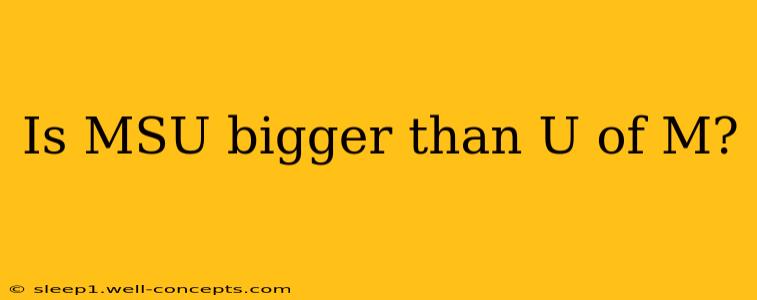The question of whether Michigan State University (MSU) or the University of Michigan (U of M) is "bigger" is multifaceted and depends on what metric you're using. Both are prominent public universities in Michigan, boasting impressive size and influence, but they differ significantly in various aspects. Let's delve into a detailed comparison to answer this question comprehensively.
Defining "Bigger": Exploring Key Metrics
Before comparing MSU and U of M, we need to clarify what "bigger" means in this context. We'll examine several key metrics:
1. Student Enrollment: Headcount and Diversity
-
U of M: Consistently enrolls a larger undergraduate student body than MSU. While precise numbers fluctuate yearly, U of M typically boasts a higher overall headcount. However, MSU's enrollment is also substantial and includes a diverse student population. Both universities have robust graduate programs, impacting overall enrollment figures. Analyzing the specific breakdown of undergraduate versus graduate students is crucial for a complete picture.
-
MSU: While having a slightly smaller undergraduate population, MSU often shows a larger total student population due to its robust professional and graduate programs, particularly in agriculture and veterinary medicine.
Conclusion: U of M generally has a larger undergraduate enrollment, but MSU might have a higher total student population depending on the year and specific program breakdowns. Neither university clearly wins on sheer student numbers alone.
2. Campus Size and Physical Footprint: Land Area and Facilities
-
MSU: MSU's campus boasts a larger physical footprint, encompassing a significantly broader land area than U of M's Ann Arbor campus. This expansive campus provides more space for research facilities, athletic fields, and student housing.
-
U of M: U of M's campus, while smaller geographically, is densely packed with buildings and facilities, creating a vibrant and bustling urban environment.
Conclusion: MSU wins in terms of sheer campus size and land area, while U of M offers a more compact and densely populated campus experience.
3. Endowment and Financial Resources: Budget and Funding
-
U of M: The University of Michigan typically holds a larger endowment than MSU, providing greater financial resources for research, scholarships, and infrastructure development. This financial advantage significantly impacts the university's overall capabilities.
-
MSU: While MSU's endowment is substantial, it's generally smaller than U of M's, potentially influencing resource allocation and expansion projects.
Conclusion: U of M possesses a larger endowment and generally greater financial resources than MSU.
4. Research Output and Academic Reputation: Publications and Rankings
Both MSU and U of M are highly respected research institutions, consistently ranking among the top universities globally. However, U of M often holds higher rankings in various academic subject areas, reflecting its extensive research output and reputation. Both universities contribute significantly to scientific advancements and knowledge creation.
Conclusion: U of M generally holds a stronger position in global university rankings and research output.
The Verdict: It Depends on Your Definition of "Bigger"
There's no single answer to whether MSU is bigger than U of M. The answer depends entirely on the metric used for comparison. MSU holds advantages in campus size and potentially overall student population (depending on the academic year and the inclusion of graduate students), while U of M surpasses MSU in endowment size, undergraduate student enrollment, and often in global university rankings and research output. Both universities are significant institutions with distinct strengths and contributions to higher education in Michigan and beyond.

